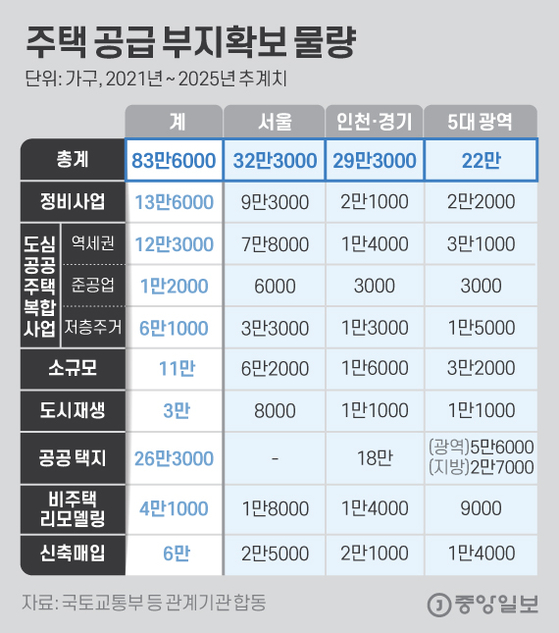The government’s 25th real estate measure (2nd and 4th measures) was announced to supply 830,000 homes nationwide, but the market’s response was dubious. There are many positive comments about the government’s supply expansion signal. However, there is an analysis that it is difficult to expect a stabilization of house prices right away in that it takes several years to move in.
According to the Ministry of Strategy and Finance and the Ministry of Land, Infrastructure and Transport on the 6th, the reason for this controversy is that there is an imaginary number in the number of ’83 million’ disclosed by the government. Specifically, the government announced that it would secure a’site’ capable of supplying 830,000 homes nationwide by 2025. However, the words “we will supply 830,000 houses” and “we will secure a site to build houses” are quite different.
![Graphic image of the amount of land for housing supply. [자료제공=국토교통부 등 관계기관 합동]](https://i0.wp.com/pds.joins.com/news/component/htmlphoto_mmdata/202102/06/bb453ffb-eef2-49ea-b5e0-bcc528d72c7c.jpg?w=560&ssl=1)
Graphic image of the amount of land for housing supply. [자료제공=국토교통부 등 관계기관 합동]
Calculated by randomly applying’expected participation rate’
No matter how much the government claims that it is a record-breaking supply, if the private sector, such as individual land owners, does not participate, the supply of goods in the actual implementation process may not meet expectations. In fact, the lands that the government said it would secure are private lands such as station areas, semi-industrial sites, and maintenance projects.
In particular, the figures revealed by the government were’estimated’ using an unfamiliar concept of’expected participation rate’ (the percentage expected to participate in the project). It targets all possible candidate sites for supply, and this ratio is the quantity expected to participate in the second and fourth measures.
For example, considering that the participation rate for public redevelopment contests is 25.9%, the government said it would supply 136,000 households with the expectation that 25% of the total will participate in the maintenance area in Seoul and 12.5% in the maintenance area in Incheon and Gyeonggi Province. However, it is still unclear whether the reconstruction and redevelopment associations will respond positively to the various incentives proposed by the government this time, and how many places will participate in the government-led housing supply plan.

Housing supply insufficient even in natural demand. Graphic = Reporter Park Kyung-min [email protected]
The key to success is response from the market
Actual reconstruction and redevelopment demand surveys were not conducted. An official from the government explained, “We did a detailed estimate by classifying the difficulty level by district type,” and “We did not conduct a prior survey.” This is the background of the fact that the details of how to develop where and how to develop the 2·4 measures are omitted.
In the end, the question is how much the market responds to the projects the government has proposed this time. Dae-Jung Kwon, professor of real estate at Myongji University, said, “I think it will have an impact on the market if it is supplied according to the government plan. “If you can get a new house quickly and don’t pay for reconstruction, you will get enough attention,” said Paik Jun, CEO of J&K Urban Development. “Would you like to participate in places where the project is sluggish or in its infancy?”
The Housing Industry Research Institute, Kim Deok-rye, advised, “Even if it is implemented by the public, it is a difficult model to succeed unless the private sector, including residents, participate actively.”

Gangnam reconstruction complex reaction is lukewarm
Gangnam Grand Complex, which has good business potential, is an atmosphere to watch and judge more. It is positive that the company has been able to speed up the business outside of regulatory changes, but it is because the public takes the initiative and the possession of property rights infringement is an obstacle. Jeong Bok-moon, president of the Jugong Complex 5 in Jamsil-dong, Songpa-gu, which has about 4,000 households, said, “I don’t know how much I will approve of the public implementation, which is likely to be of poor quality because residents want to build luxury apartments representing the region through reconstruction.
Even if the business participation rate is high, there may not be an immediate stabilizing effect in the market. This is because it takes quite a long time to actually move in. An official from the Ministry of Land, Infrastructure and Transport said, “The goal is to secure the site by 2025. It will take about three more years to move in.”
Young-jin Ham, head of Jikbang’s Big Data Lab, pointed out, “It would be better to recognize the stability of house prices as a mid- to long-term effect rather than a short-term effect. He explained, “It is limited to completely evolve the stability of jeon/month rent prices or anxiety about rising house prices in the short term,” he said. “However, we are expecting the effect of slowing the rise in house prices.”
Sejong = Reporter Son Hae-yong [email protected]
